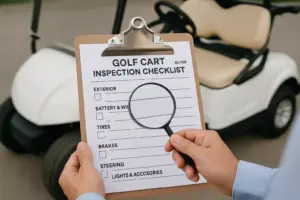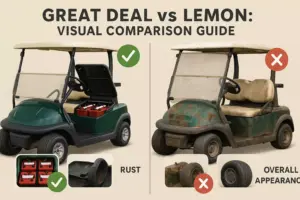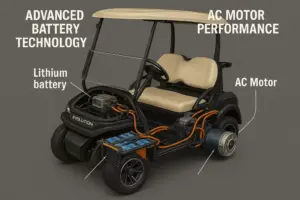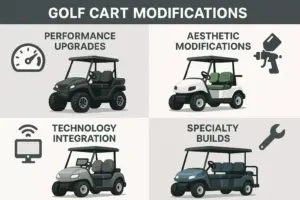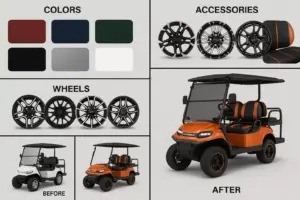The Pros and Cons of Buying a Used Golf Cart in 2025
Golf carts have evolved far beyond their traditional role on the fairway. In 2025, these versatile vehicles are transforming neighborhoods, retirement communities, and recreational areas across the country. With over 1.3 million golf carts now operating in the United States, the used golf cart market has become a thriving industry worth billions of dollars. Whether you’re considering a pre-owned cart for weekend golf rounds, neighborhood transportation, or commercial use, understanding the advantages and disadvantages is crucial for making an informed decision.
Key Takeaways

- Cost savings of 30-60% compared to new golf carts make used options attractive for budget-conscious buyers
- Depreciation concerns and potential maintenance issues require careful inspection and research before purchase
- Battery condition in electric models is the most critical factor affecting long-term ownership costs
- Local regulations and intended use should guide your decision between gas and electric models
- Thorough inspection and buying from reputable dealers significantly reduces risks associated with used purchases
The Growing Appeal of Used Golf Carts
The golf cart industry has experienced remarkable growth, with annual sales exceeding 200,000 units in 2025. This surge in popularity has created a robust secondary market where savvy buyers can find excellent deals on quality pre-owned vehicles.
Market Trends Driving Demand 📈
- Aging population seeking convenient transportation solutions
- Environmental consciousness favoring electric alternatives
- Rising fuel costs making electric carts more appealing
- Expanded use cases beyond golf courses
- Technological improvements increasing cart longevity and performance
Advantages of Buying Used Golf Carts
1. Significant Cost Savings 💰
The most compelling reason to consider a used golf cart is the substantial financial advantage. New golf carts typically range from $8,000 to $20,000, while comparable used models can be found for $3,000 to $12,000.
Typical Savings by Cart Type:
- Basic electric models: 40-50% savings
- Gas-powered carts: 35-45% savings
- Luxury/custom models: 50-60% savings
2. Immediate Availability
Unlike new carts that may require 6-12 weeks for delivery, used golf carts are typically available for immediate purchase and pickup. This advantage is particularly valuable during peak seasons when new cart inventory runs low.
3. Proven Reliability
Well-maintained used golf carts have demonstrated their durability and performance over time. Buyers can research specific models and years to identify those with the best track records for reliability and longevity.
4. Lower Insurance Costs
Insurance premiums for used golf carts are generally 15-25% lower than those for new vehicles, providing ongoing savings throughout ownership.
5. Reduced Registration Fees
Many states base registration fees on vehicle value, meaning used golf carts incur lower annual registration costs compared to new models.
6. Established Modification Market
The used golf cart market offers extensive aftermarket parts and accessories, often at lower prices than OEM components. This makes customization more affordable and accessible.
Disadvantages of Buying Used Golf Carts
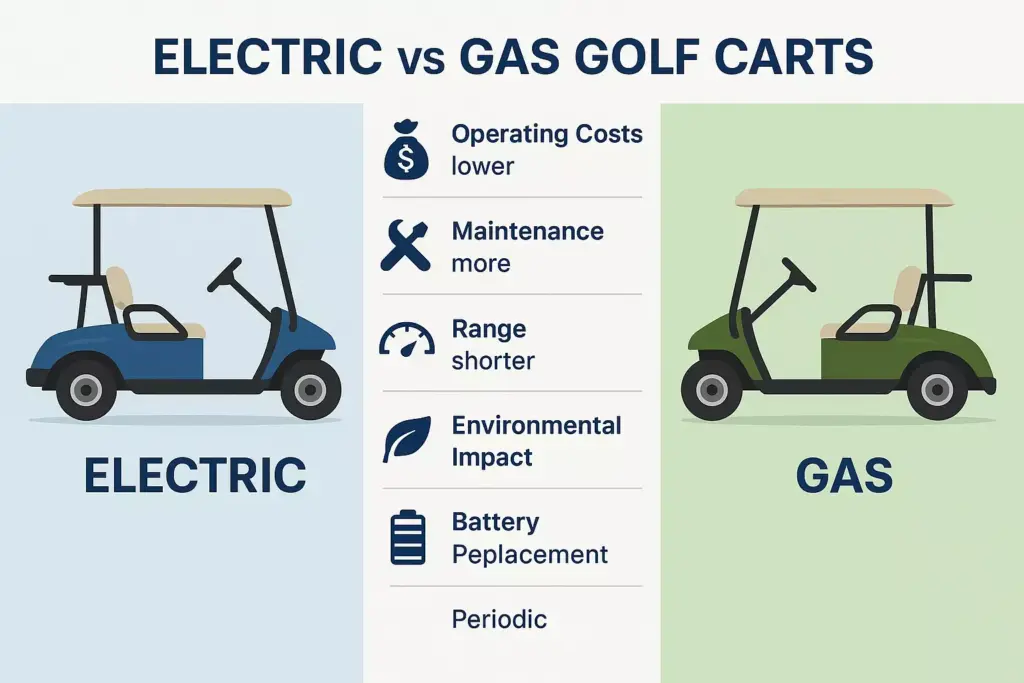
1. Battery Replacement Costs ⚡
For electric golf carts, battery replacement represents the most significant potential expense. A new set of batteries can cost $800 to $2,000, potentially eliminating much of the initial savings from buying used.
Battery Warning Signs:
- Reduced range between charges
- Longer charging times
- Visible corrosion or damage
- Age exceeding 4-5 years
2. Limited or No Warranty Coverage
Most used golf carts come with minimal warranty protection, leaving buyers responsible for all repair costs. This contrasts sharply with new carts that typically include 2-4 year comprehensive warranties.
3. Unknown Maintenance History
Without complete service records, buyers face uncertainty about previous maintenance quality and potential hidden issues that may surface after purchase.
4. Technology Gaps
Older used models may lack modern features such as:
- LED lighting systems
- USB charging ports
- Advanced battery management
- Improved suspension systems
- Enhanced safety features
5. Potential for Hidden Damage
Used golf carts may have experienced accidents, floods, or abuse that isn’t immediately apparent during a casual inspection but could lead to expensive problems later.
6. Limited Financing Options
Banks and credit unions typically offer fewer financing programs for used golf carts, potentially requiring cash purchases or higher interest rates.
Electric vs. Gas: Used Cart Considerations
Electric Golf Carts
Advantages:
- Lower operating costs (electricity vs. gasoline)
- Quieter operation
- Zero emissions
- Less maintenance required
Disadvantages:
- Battery replacement costs
- Limited range (typically 25-40 miles)
- Longer refueling time (charging)
- Performance degradation in cold weather
Gas Golf Carts
Advantages:
- Longer range capabilities
- Quick refueling
- Better performance in varied terrain
- No battery replacement concerns
Disadvantages:
- Higher fuel costs
- Regular maintenance requirements
- Emissions and noise
- More complex mechanical systems
What to Inspect When Buying Used
Essential Inspection Checklist ✅
Body and Frame:
- Check for rust, dents, or structural damage
- Inspect seat condition and functionality
- Verify all lights and electrical components work
- Test steering alignment and responsiveness
Mechanical Components:
- Examine tire condition and tread depth
- Test brakes for proper operation
- Check suspension for wear or damage
- Inspect belts, hoses, and fluid levels (gas models)
Electrical System:
- Test battery voltage and capacity (electric models)
- Verify charger functionality
- Check all electrical connections
- Test motor performance under load
Documentation:
- Request maintenance records
- Verify ownership and title
- Check for any liens or encumbrances
- Confirm compliance with local regulations
Where to Buy Used Golf Carts
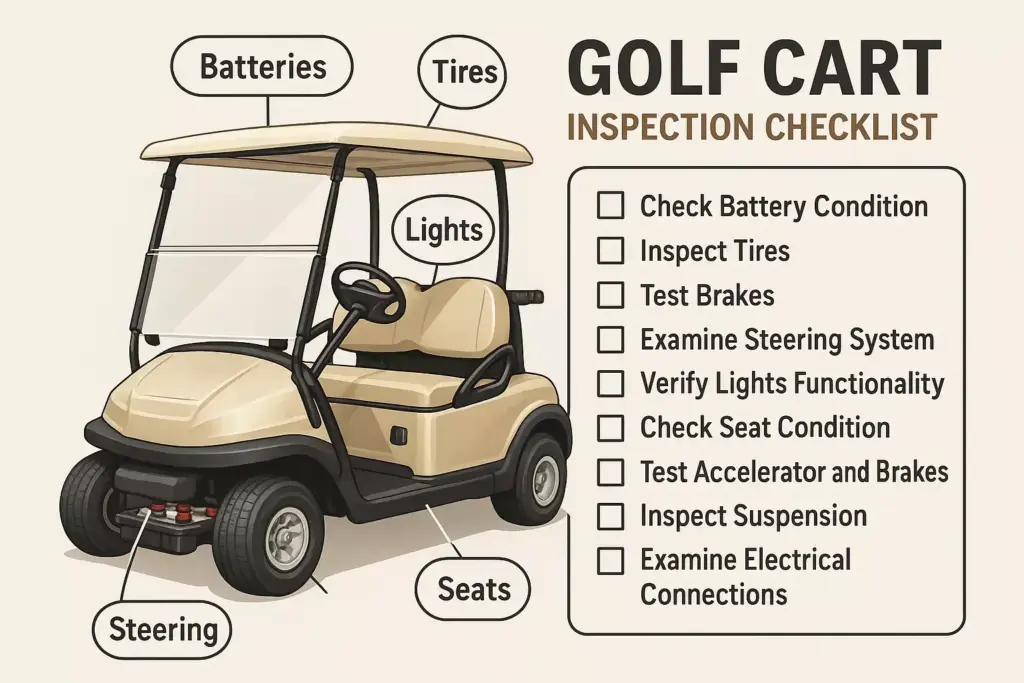
Authorized Dealers 🏪
Pros:
- Professional inspections
- Limited warranties available
- Financing options
- Trade-in possibilities
Cons:
- Higher prices
- Limited inventory
- Less negotiation flexibility
Private Sellers
Pros:
- Lower prices
- Direct negotiation
- Complete ownership history available
Cons:
- No warranty protection
- Limited recourse for problems
- Cash transactions typically required
Online Marketplaces
Pros:
- Wide selection
- Price comparison opportunities
- Detailed photos and descriptions
Cons:
- Cannot inspect before purchase
- Shipping costs and logistics
- Higher risk of misrepresentation
Golf Course Fleet Sales
Pros:
- Well-maintained vehicles
- Bulk purchasing opportunities
- Known usage patterns
Cons:
- High mileage/hours
- Limited model variety
- Seasonal availability
Financing and Insurance Considerations
Financing Options 💳
Traditional Auto Loans:
- Available through banks and credit unions
- Typically 3-7 year terms
- Interest rates: 4-12% depending on credit
Dealer Financing:
- Convenient one-stop shopping
- May offer promotional rates
- Often more flexible credit requirements
Personal Loans:
- Unsecured financing option
- Higher interest rates (8-18%)
- Faster approval process
Insurance Requirements
Most states require liability insurance for golf carts operated on public roads. Comprehensive coverage is recommended to protect against:
- Theft and vandalism
- Weather damage
- Collision damage
- Personal injury liability
Maintenance and Ownership Costs
Annual Maintenance Expenses
Electric Golf Carts:
- Battery maintenance: $100-200
- General upkeep: $150-300
- Tire replacement: $200-400 (every 3-4 years)
Gas Golf Carts:
- Engine maintenance: $200-400
- Fuel costs: $300-600 annually
- General upkeep: $200-400
Long-term Ownership Considerations
Factors Affecting Resale Value:
- Brand reputation and model popularity
- Maintenance history and condition
- Market demand in your area
- Technological obsolescence
Legal and Regulatory Factors

Street Legal Requirements 🚦
Many jurisdictions allow golf carts on public roads with specific modifications:
- Safety equipment: Mirrors, seat belts, lights
- Speed limitations: Typically 25-35 mph maximum
- Registration and licensing: Varies by state
- Insurance requirements: Mandatory in most areas
HOA and Community Regulations
Before purchasing, verify that your intended use complies with:
- Homeowner association rules
- Community guidelines
- Local noise ordinances
- Parking and storage requirements
🏌️ Used Golf Cart Cost Calculator
Calculate potential savings and total ownership costs
💰 Total Savings vs New: $0
Based on your inputs, buying used could save you this amount over 5 years
Making the Right Decision
When to Buy Used 👍
Consider a used golf cart when:
- Budget constraints make new carts unaffordable
- Occasional use doesn’t justify new cart investment
- Specific older models offer desired features
- Quick availability is essential
- Local dealer support is available for used carts
When to Buy New 👎
Choose a new golf cart when:
- Heavy daily use is planned
- Latest technology and features are important
- Warranty protection provides peace of mind
- Financing incentives make new carts competitive
- Long-term ownership (10+ years) is anticipated
Tips for Successful Used Cart Buying
Research Before You Buy 🔍
Model-Specific Research:
- Read owner reviews and forums
- Check recall notices and common problems
- Compare prices across multiple sources
- Identify parts availability and costs
Dealer Reputation:
- Check Better Business Bureau ratings
- Read customer reviews and testimonials
- Verify licensing and certifications
- Ask for references from recent buyers
Negotiation Strategies
Effective Negotiation Tactics:
- Research comparable sales prices
- Point out needed repairs or maintenance
- Consider timing (end of season, model year)
- Bundle accessories or services
- Be prepared to walk away
Post-Purchase Considerations
Immediate Actions:
- Schedule professional inspection
- Update insurance coverage
- Register with local authorities
- Establish maintenance schedule
- Join owner groups or forums
Future Trends in the Used Golf Cart Market
Technology Integration 📱
The 2025 used golf cart market reflects rapid technological advancement:
- Smart connectivity features
- GPS navigation systems
- Solar charging capabilities
- Advanced battery management
- App-based monitoring
Market Predictions
Industry experts predict:
- Continued growth in used cart demand
- Increased standardization of safety features
- Expansion of street-legal regulations
- Growing acceptance in urban transportation
- Enhanced resale value retention
Conclusion
Buying a used golf cart in 2025 presents both significant opportunities and important considerations. The potential savings of 30-60% make used carts attractive for budget-conscious buyers, while the risks of battery replacement and maintenance issues require careful evaluation.
Key success factors include thorough research, professional inspection, and realistic expectations about ownership costs. Electric carts offer lower operating expenses but may require expensive battery replacement, while gas models provide reliability with higher ongoing fuel and maintenance costs.
Your next steps should include:
- Determine your specific needs and intended use patterns
- Set a realistic budget including potential repair costs
- Research reputable dealers and private sellers in your area
- Schedule professional inspections before making any purchase
- Secure appropriate insurance and verify local regulations
The used golf cart market in 2025 offers excellent value for informed buyers who approach the purchase process with proper preparation and realistic expectations. Whether you choose electric or gas, basic or luxury features, a well-researched used golf cart purchase can provide years of reliable, cost-effective transportation and recreation.

